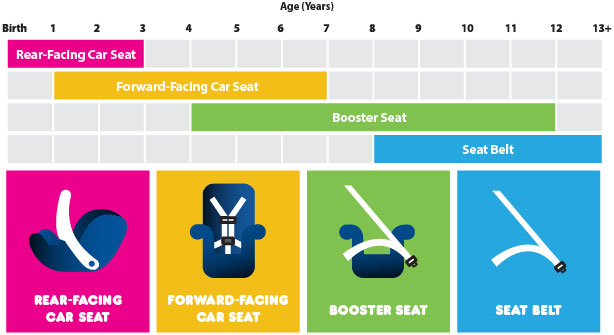Protect your children on the road: 3 car seat safety tips
Posted in Accident & Injury on October 6, 2016
Do you know which type of car seat would keep your child safest in a crash?
When used properly, car seats greatly reduce a child’s risk of being killed in a motor vehicle accident. However, nearly half of car and booster seats are not used or installed correctly. Keep your little ones safe on the road by following these car seat safety tips.
3 Car Seat Safety Tips
1. Choose the right car seat.
No child should ride in a forward-facing seat before they turn two. Ideally, children should remain in a rear-facing seat until they outgrow the height and weight limit designated by the seat’s manufacturer. Convertible and all-in-one seats typically offer higher weight and height limits, which can help delay the transition.

Graphic courtesy of safecar.gov.
Not sure which option is safest for your child? Use this tool to find the right fit, and take extra precautions if you’re purchasing a used car seat or accepting a hand-me-down from a friend or relative.
2. Be sure the seat is correctly installed.
Aside from choosing the wrong type of seat or switching a child to a front-facing model too soon, one of the most common mistakes parents make is failing to use the seat belt or LATCH system properly when securing the car seat. SafeCar.gov, powered by the National Highway Traffic Safety Administration, offers comprehensive video instructions on the proper way to install each type of car seat.
3. Register your child’s car seat.
Even if you’ve purchased the safest model and installed it correctly, a defective car seat could still put your child in serious danger. Opt to receive recall notifications for the models of car seats used by your family to minimize the chances of a defect going unnoticed.
Consider having your car seat inspected by a professional to ensure your child is as safe as possible when you hit the road. Contact your local hospital or fire department, find a trained technician in your area or attend an upcoming car seat checkup event.